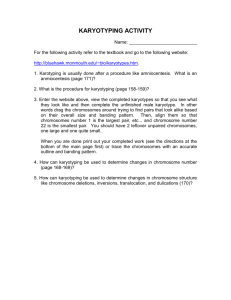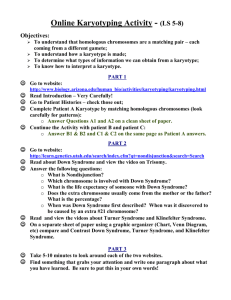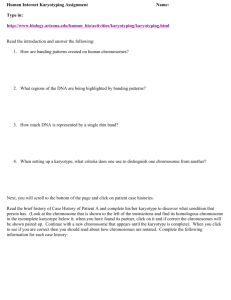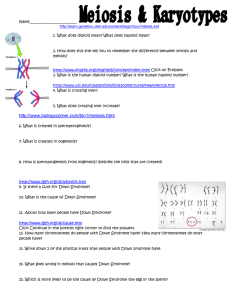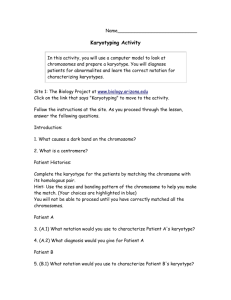File
advertisement
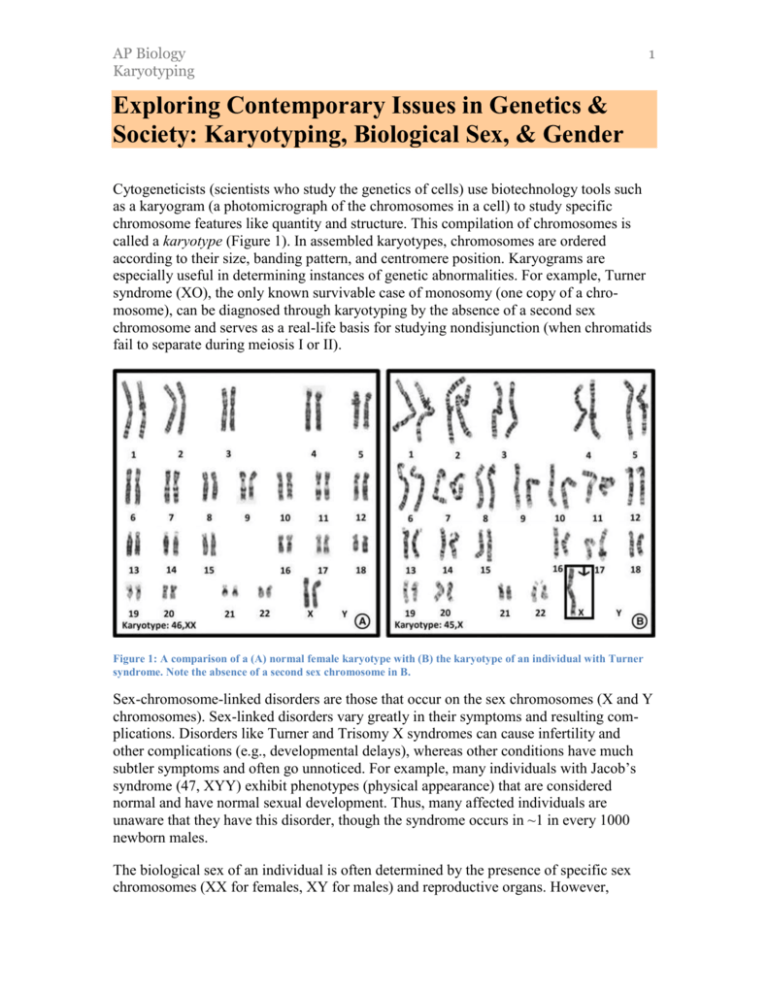
AP Biology Karyotyping 1 Exploring Contemporary Issues in Genetics & Society: Karyotyping, Biological Sex, & Gender Cytogeneticists (scientists who study the genetics of cells) use biotechnology tools such as a karyogram (a photomicrograph of the chromosomes in a cell) to study specific chromosome features like quantity and structure. This compilation of chromosomes is called a karyotype (Figure 1). In assembled karyotypes, chromosomes are ordered according to their size, banding pattern, and centromere position. Karyograms are especially useful in determining instances of genetic abnormalities. For example, Turner syndrome (XO), the only known survivable case of monosomy (one copy of a chromosome), can be diagnosed through karyotyping by the absence of a second sex chromosome and serves as a real-life basis for studying nondisjunction (when chromatids fail to separate during meiosis I or II). Figure 1: A comparison of a (A) normal female karyotype with (B) the karyotype of an individual with Turner syndrome. Note the absence of a second sex chromosome in B. Sex-chromosome-linked disorders are those that occur on the sex chromosomes (X and Y chromosomes). Sex-linked disorders vary greatly in their symptoms and resulting complications. Disorders like Turner and Trisomy X syndromes can cause infertility and other complications (e.g., developmental delays), whereas other conditions have much subtler symptoms and often go unnoticed. For example, many individuals with Jacob’s syndrome (47, XYY) exhibit phenotypes (physical appearance) that are considered normal and have normal sexual development. Thus, many affected individuals are unaware that they have this disorder, though the syndrome occurs in ~1 in every 1000 newborn males. The biological sex of an individual is often determined by the presence of specific sex chromosomes (XX for females, XY for males) and reproductive organs. However, AP Biology Karyotyping 2 classifying biological sex as a binary (i.e., male–female) is often problematic because not all individuals adhere to these norms. For example, the SRY gene (sex-determining region of the Y chromosome) is characteristic in males and leads to testis formation. Yet it is plausible for a male to carry the female genotype (genetic composition) XX but still be considered male, because one X chromosome contains a copy of this SRY gene. Moreover, Klinefelter syndrome (47, XXY), the result of nondisjunction of the X chromosome during meiosis I, produces simultaneous male and female sexual development in individuals. Yet, outwardly, people with Klinefelter often exhibit many phenotypic characteristics associated with being male – for example, tall height and broad shoulders. Hence, the terms sex and gender are often used interchangeably, despite socially recognized differences between the two. Social scientists contend that gender includes the ways individuals act and look. Moreover, gender is taught through the process of socialization. Thus, gender is driven by socially determined norms, such as females wearing makeup or males playing contact sports. These actions produce different feelings, relationships, and skills in individuals. Although it may be socially acceptable to view gender as a binary (male–female, boy– girl), this is problematic and marginalizes those who do not fit neatly into one gender category. Sex-chromosome-linked disorders ultimately lead to questions like “What does it mean to be a girl or boy?” Such questions may seem trivial to individuals who fit neatly into either gender label, but for people who do not, these are questions of paramount importance, with real consequences for not fitting neatly into those categories.

